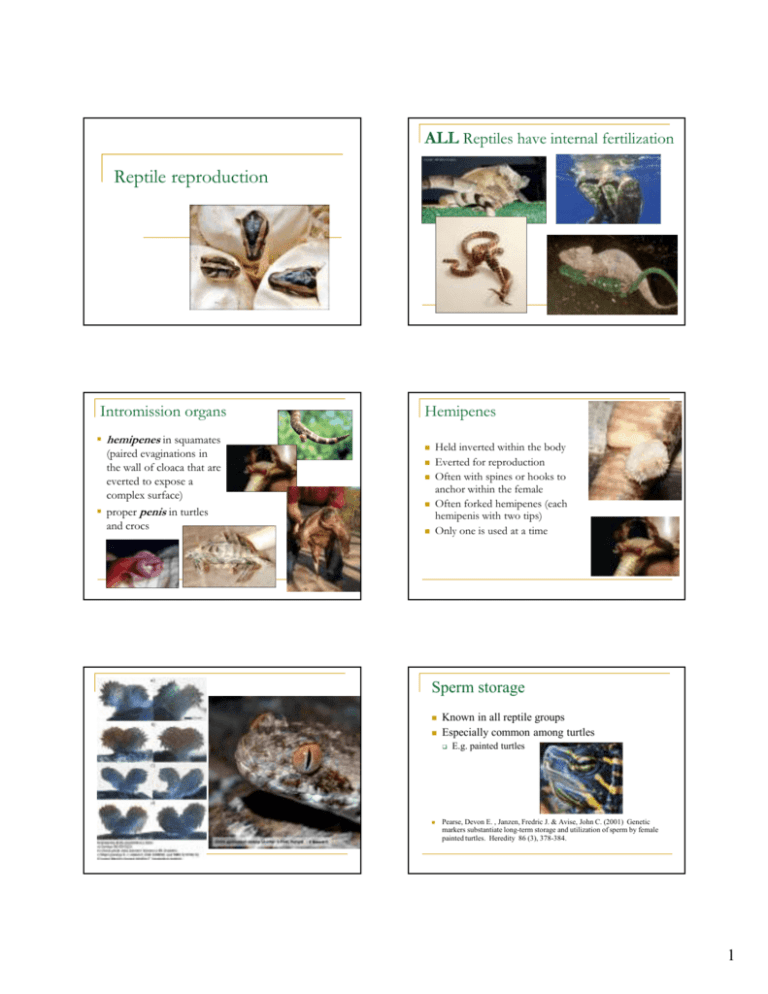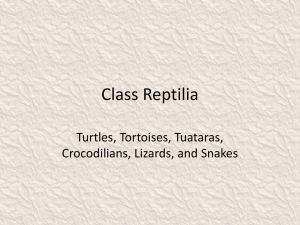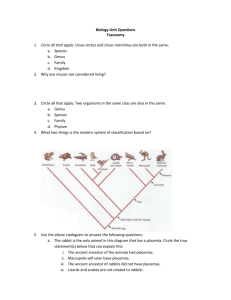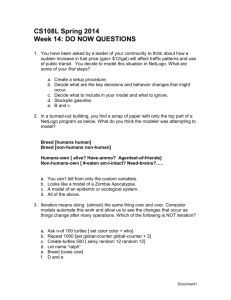Reptile reproduction
advertisement

ALL Reptiles have internal fertilization Reptile reproduction Intromission organs hemipenes in squamates (paired evaginations in the wall of cloaca that are everted to expose a complex surface) proper penis in turtles and crocs Hemipenes Held inverted within the body Everted for reproduction Often with spines or hooks to anchor within the female Often forked hemipenes (each hemipenis with two tips) Only one is used at a time Sperm storage Known in all reptile groups Especially common among turtles E.g. painted turtles Pearse, Devon E. , Janzen, Fredric J. & Avise, John C. (2001) Genetic markers substantiate long-term storage and utilization of sperm by female painted turtles. Heredity 86 (3), 378-384. 1 Findings Microsatellite markers on free-ranging population over four years Genotyped 113 clutches: 80.5% remated each year But some females used sperm stored for up to three years to fertilize some or all eggs laid in consecutive nesting seasons. 13.2% of all clutches examined showed evidence of multiple paternity Suggests 'last in, first out' operation of the females' sperm storage tubules Reptiles have two reproductive modes Oviparity: egg laying All turtles, crocodiles (and birds) Some squamates (snakes, lizards and amphisbaenids) Viviparity: live-bearing Only found in snakes, lizards and amphisbaenids Has evolved independently more than 100 times Reptile eggs Huge size variation among spcies Largest eggs ~ 300 g (pythons) smallest eggs ~ 0.1 g (geckos) Two layers: Reptile Eggs outer mineral layer of calcium carbonate inner layer or shell membrane Basic reptile egg structure Embryo Amnion= cushion membrane Yolk sac= nutrition Allantois= waste sac Chorion= membrane immediately inside shell Albumin = egg white Shell: hard or leathery Respiration occurs through the shell 2 The link ed image cannot be display ed. The file may hav e been mov ed, renamed, or deleted. Verify that the link points to the correct file and location. Egg teeth What is the optimal number and size of eggs? More egg teeth… Assists in hatching by splitting the inner membrane and cracking the outer membrane of the egg. It is not a true tooth, and it is resorbed a few weeks after hatching Viviparity Retention of embryos within the oviducts until development is complete = live birth. During evolution, viviparity has been accomplished by gradual increases in the amount of time eggs are retained in oviducts. Common where environment is too cold or too short to allow normal development Northern water snake Nerodia sipedon occupies cold waters. Females spend much of their time optimizing the thermal environment for their young (that is, basking) Produce large litters of young (20-40) Males stay small and concentrate primarily on survival Common in some groups - caecilians and squamates Absent in others - turtles & crocs Female searches for microenviroments suitable for embryo development Hastens development well beyond that possible in nest chambers. No need for nesting! Sex Determination Genetic in most species But in most turtles, all crocs, tuatara, and some squamates it is temperature dependent (“TSD”) Generally a pivotal temperature at which 50% of individuals are of each sex 3 Incubation temperature and sex ratio in the red-eared slider (Trachemys scripta) Type Ia TSD More males than females are produced at higher temperatures Typical of some crocodilians and some lizards Proportion males More females than males are produced at higher temperatures– e.g., many species of turtles (e.g. Loggerhead sea turtle Caretta caretta). Proportion males Type Ib TSD Temperature Temperature Type II Females are produced at low and high incubation temperatures with males at intermediate temperatures -- observed in some lizards (Eublepharis macularis), some crocodilians (Crocodylus johnstoni), and some turtles (Chelydra serpentina). Proportion males Mechanisms of TSD? Temperature Still poorly known Likely a link to temperature control of production of sex hormones in embryo Possibly related to males and females being more fit if raised at different temperatures Permits female to choose the sex of her offspring by nesting in cooler or warmer sites Latest news…SD may continue into hatchling stage! 4 TSD, offspring sex choice, and turtles • Females can chose sex of offspring by nesting in cool versus warm sites Why choose? Adult females are almost always larger than males of the same species Turtles shell size correlates with how many eggs the female can carry; larger turtles means greater reproduction in females Male size is unimportant for reproductive fitness – small males quite adept at mating So…what do you predict for a nesting site selection in a “bad year” or high density conditions? GSD: Conservation Implications of TSD (the exception) ? Hatchling loggerhead turtles in Florida from 87 to 99.9 percent females a 2 degree C warming of the sand would put temperatures solidly in the female- producing range for the entire population (N. Mrosvovsky and J. Provancha, "Sex ratio of hatchling loggerhead sea turtles: data and estimates from a 5-year study, " Canadian Journal of Zoology, v. 70, p. 530 - 538, 1992). 5 Turtles and Global Warming Can turtles adapt? Projected temperature changes ~ 2-3 degrees C Slow generation times Remote possibility that turtles can evolve quickly enough to track such environmental change and maintain balanced sex ratios in the wild. Painted Turtles - From Janzen PNAS (1994) Sex Ratios of freshwater turtles Parental Care (Dave Steen MS EFB 2003) Nearly all crocodilians care for their young 0 .7 About 100 species of squamates exhibit some type of parental care 0 .6 1 0 .9 Fra c tio n m a le s 0 .8 0 .5 0 .4 0 .3 0 .2 1 93 0 1 94 0 1950 19 6 0 1 9 70 1 9 80 19 9 0 20 0 0 E.g. egg brooding in pythons Egg attendance Turtles rarely if ever exhibit parental care 0 .1 0 1920 Likely necessary to defend against predators Likely has costs without major benefits Time energy and increased predation 2 0 10 Y ear Parthenogenesis – reproduction without sex A few reptiles reproduce asexually In most cases these species: ~ 30 squamate species (mostly lizards, only one snake) Result from hybridization of two species Consist only of females Reproduce by clonal inheritance Do not require interactions with other species to reproduce Do not require sperm 6 The ‘flower pot’ snake Rhamphotyphlops braminus Successful invasive species Fossorial – often introduced via soil of imported plants Introduced throughout the tropics and even in greenhouses from Florida to Ohio A single female can be the founder of an entire new population because of parthenogenesis Aspidoscelis uniparnes – desert grassland whiptail lizard Parthenogenetic One of ~15 unisexual all female lizard species Aspidoscelis uniparnes – desert grassland whiptail lizard Pseudocopulation One female plays the role of the male Display courtship behavior that increases gonadal activity (as in many unisexual species) End: Reptile reproduction 7









